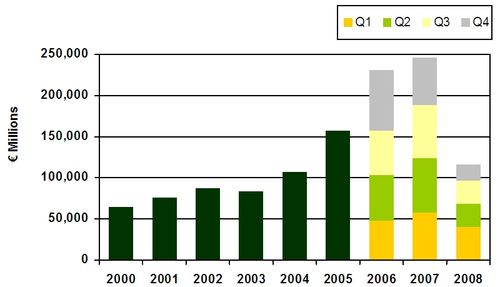The forth quarter 2008 confirmed standstill of investment activities
CB Richard Ellis Group (CBRE) Advisory Company brought finally the news on the last quarter of last year, too. Exactly as it was expected, European finances to commercial estates dropped from 27.7 to 19.5 bills Euro in this period, what brought the level of total turnover in year 2008 comparable with year 2004 – thus 116 bills Euro. The total turnover of investments to commercial estates achieved 9.5 bills Euro in the Central and Eastern Europe according to the CBRE survey, what is by 37 percentage less than in year 2007 else, but by 47 percentage more than in year 2005. Extremely bad felt the trade volume of business closed in the monitored period – by 580 mills Euro only. It is direct result of the combination of such effects like temporary freeze of German open funds, credit policy quenching as well as unclear development of pricing as to Josa Trompa, the chief of Research & Consulting for Central and Eastern Europe (CEE).
The alternative financing is the key
The main cause of the break in trade volumes was unwillingness of banks to lend money, in connection with the global crisis. Financing investments to real estates in the Central and Eastern Europe is also becoming limited due to lack of liquidity and improvement in a short time horizont is unlikely. Banks themselves will remain in risk in year 2009 henceforward that is why trading will be complicated. However, sufficiency of own capital while placing contracts is necessary.
Some „light at the end of tunnel“ is a fact, that bank sector will have to return to lending money earlier or later in order to support expectations of their shareholders. Making loans to selected key and trustworthy clients will refresh probably in the second half-year 2009, whereas the restriction will touch speculative projects financing at most.
„Present state is the return back to year 2005, when totally 6 bills Euro was at the investment trade. It looks less compared with the state from years 2006–2007, when substantially more funds like now was aimed to the Central and Eastern Europe. However, it is interesting that the market did not look small for those times, “Pavel Schanka, the CEE Capital Markets director (of the investment department for the Central and Eastern Europe), comments the situation.
Seeing that banks will apparently remain in their credit policy restrictively, the alternative investment will be the key for year 2009. This year German open funds could return here in his view. The CBRE Company found, that besides them more than 3.5 bills Euro is available to be invested to real estates in the Central and Eastern Europe.
A gap between buyers and sellers
Limited number of buyers on the market causes, that investors will focus on the real assets producing profit involving stable occupation and long-term hiring contracts. Timing of sells and price accessibility are important factors for optimising revenues. Momentarily the market is static relatively – expectations of most buying and selling people are not balances namely. Increased carefulness results from general industrial uncertainty.
The contrast between the 3rd and the 4th quarter was also influenced strongly by the collapse of the American investment bank Lehman Brothers as well and credit chaos deepening, what impacted on the trust of investors negatively. Because of the credit crises claimed its tax from economy, many European countries slipped to negative prognosis of economic growth. Although investment activities dropped in Europe during last quarter by 29 percentages compared with the third one, this result does not catch several important transactions in the entire amount of 1.65 bills Euro nearly before the end-year closing.
Own capital and institutional buyers, who were dominant players in year 2008, will play the key role henceforward while investing to real assets in a short future. Michael Haddock, the director of EMEA Capital Markets Research of CBRE Company estimates: „During last quarter of year 2008 there was substantial growth of main revenues in whole Europe – in an average between 30 and 40 of basic rates. It will contribute in a way to vault over the gap between buyers and sellers and will prepare conditions for higher level of activities in year 2009. Jonathan Hull, the executive director of the EMEA Capital Markets CBRE is attaching to it: „Although European investments slowed-down during last quarter of 2008 in general, investors start express increased interest in some markets. The newest example is the Great Britain, especially central London, which becomes attractive for long-term investing. Recent deepen of English pound offers another advantage for several foreigner investors and funds nominated in foreign currency. “
As following table also displays, excluding Italy, French and Germany, investments to real assets in most of European countries dropped in the fourth quarter.
| Financial turnover in mills € | 4Q 2008 | 3Q 2008 | Diference |
| Great Britain | 4,973 | 5,369 | -7% |
|---|---|---|---|
| Germany | 3,804 | 3,746 | 2% |
| France | 2,808 | 2,491 | 13% |
| Italy | 2,618 | 927 | 182% |
| Scandinavia | 2,019 | 8,736 | -77% |
| Benelux | 1,165 | 1,337 | -13% |
| Spanish | 814 | 1,419 | -43% |
| Central and Eastern Europe | 501 | 2,927 | -83% |
| Europe | 19,520 | 27,681 | -29% |
Graph – European investments: the level of business trade volume in year 2008 is comparable with year 2004. Source: CBRE

Illustrative visualization– J&T Table and graph – CB Richard Ellis



 Jagg.cz
Jagg.cz Linkuj.cz
Linkuj.cz Google Bookmarks
Google Bookmarks Live bookmarks
Live bookmarks Digg
Digg Del.icio.us
Del.icio.us MySpace
MySpace Facebook
Facebook